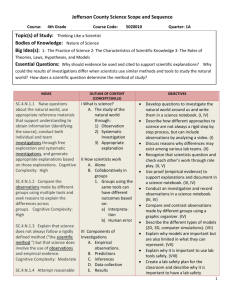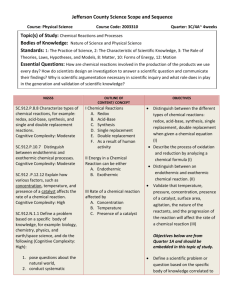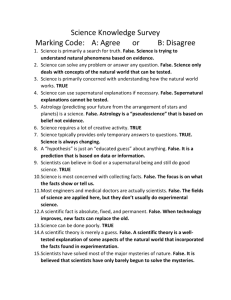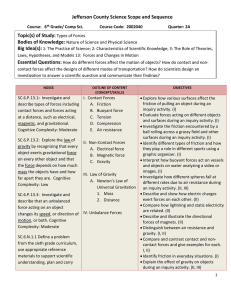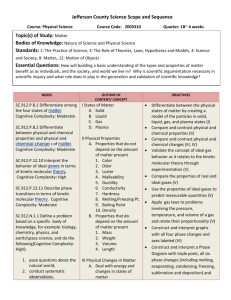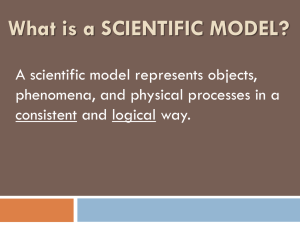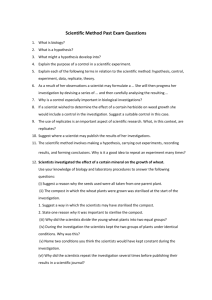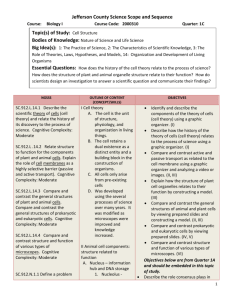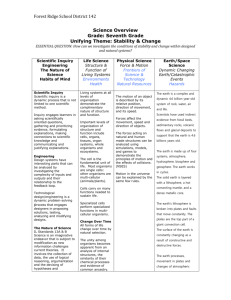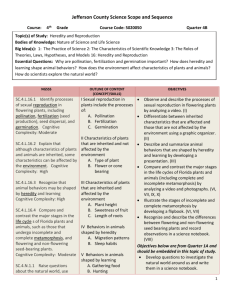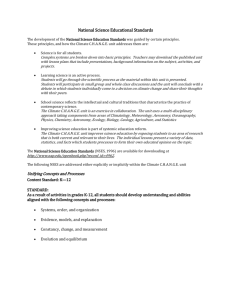Topic 1: Thinking Like a Scientist
advertisement
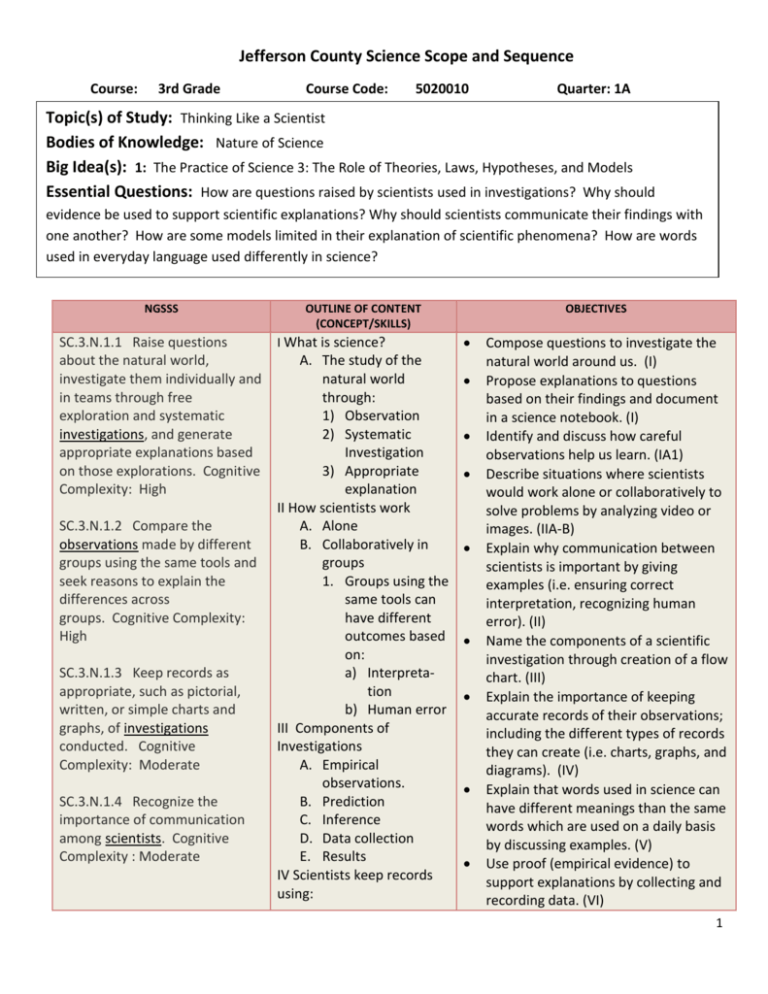
Jefferson County Science Scope and Sequence Course: 3rd Grade Course Code: 5020010 Quarter: 1A Topic(s) of Study: Thinking Like a Scientist Bodies of Knowledge: Nature of Science Big Idea(s): 1: The Practice of Science 3: The Role of Theories, Laws, Hypotheses, and Models Essential Questions: How are questions raised by scientists used in investigations? Why should evidence be used to support scientific explanations? Why should scientists communicate their findings with one another? How are some models limited in their explanation of scientific phenomena? How are words used in everyday language used differently in science? NGSSS SC.3.N.1.1 Raise questions about the natural world, investigate them individually and in teams through free exploration and systematic investigations, and generate appropriate explanations based on those explorations. Cognitive Complexity: High SC.3.N.1.2 Compare the observations made by different groups using the same tools and seek reasons to explain the differences across groups. Cognitive Complexity: High SC.3.N.1.3 Keep records as appropriate, such as pictorial, written, or simple charts and graphs, of investigations conducted. Cognitive Complexity: Moderate SC.3.N.1.4 Recognize the importance of communication among scientists. Cognitive Complexity : Moderate OUTLINE OF CONTENT (CONCEPT/SKILLS) I What is science? A. The study of the natural world through: 1) Observation 2) Systematic Investigation 3) Appropriate explanation II How scientists work A. Alone B. Collaboratively in groups 1. Groups using the same tools can have different outcomes based on: a) Interpretation b) Human error III Components of Investigations A. Empirical observations. B. Prediction C. Inference D. Data collection E. Results IV Scientists keep records using: OBJECTIVES Compose questions to investigate the natural world around us. (I) Propose explanations to questions based on their findings and document in a science notebook. (I) Identify and discuss how careful observations help us learn. (IA1) Describe situations where scientists would work alone or collaboratively to solve problems by analyzing video or images. (IIA-B) Explain why communication between scientists is important by giving examples (i.e. ensuring correct interpretation, recognizing human error). (II) Name the components of a scientific investigation through creation of a flow chart. (III) Explain the importance of keeping accurate records of their observations; including the different types of records they can create (i.e. charts, graphs, and diagrams). (IV) Explain that words used in science can have different meanings than the same words which are used on a daily basis by discussing examples. (V) Use proof (empirical evidence) to support explanations by collecting and recording data. (VI) 1 Jefferson County Science Scope and Sequence SC.3.N.1.5 Recognize that scientists question, discuss, and check each others' evidence and explanations. Cognitive Complexity: Moderate SC.3.N.1.6 Infer based on observation. Cognitive Complexity: High SC.3.N.1.7 Explain that empirical evidence is information, such as observations or measurements that is used to help validate explanations of natural phenomena. Cognitive Complexity: High SC.3.N.3.1 Recognize that words in science can have different or more specific meanings than their use in everyday language; for example, energy, cell, heat/cold, and evidence. Cognitive Complexity: Moderate SC.3.N.3.2 Recognize that scientists use models to help understand and explain how things work. Cognitive Complexity: Low SC.3.N.3.3 Recognize that all models are approximations of natural phenomena; as such, they do not perfectly account for all observations. Cognitive Complexity: Moderate MACC.3.MD.1.2: Measure and estimate liquid volumes and masses of objects using standard units of grams (g), kilograms (kg), A. B. C. D. E. Pictures Graphic organizers Graphs Charts Written explanations V Scientists communicate to A. Share findings B. Check the accuracy of one another’s work C. Debate explanations D. Share inferences based on observations VI Empirical Evidence can validate explanations of natural phenomena A. Observations B. Measurements VII The use of models A. Visual representations B. Types of models – 1 dimensional, 2 and 3 dimensional VIII Using scientific tools and working safely A. Lab Tools 1. Used by scientists to carry out investigations 2. TEACHER NOTE: show examples of lab tools and explain their use. B. Lab Safety 1. TEACHER NOTE: download and refer to safety contract on resource page Explain why models are important but are also limited in what they can represent by examining and comparing a variety of different scientific models. (VII) Explain lab tool safety by creating a visual representation of appropriate and inappropriate behavior or procedures. (VIII) Compose a lab safety plan and discuss why it is important. (VIII) Work together in groups to complete a model science board, illustrating the components of a scientific investigation. (IX) 2 Jefferson County Science Scope and Sequence and liters (l).6 Add, subtract, 2. Identify and multiply, or divide to solve onediscuss lab step word problems involving safety tools in masses or volumes that are given classrooms in the same units, e.g., by using 3. Lab Safety Plan drawings (such as a beaker with (refer to a measurement scale) to objective) represent the problem. IX How to do a science project MACC.3.MD.2.4: Generate A. Experimental Design measurement data by measuring 1. Ask a question lengths using rulers marked with 2. Plan halves and fourths of an inch. investigation Show the data by making a line a) Identify plot, where the horizontal scale independent is marked off in appropriate variable units— whole numbers, halves, (what is or quarters. being tested) b) Determine LACC.3.RI.1.3: Describe the the relationship between a series of dependent historical events, scientific ideas variable or concepts, or steps in technical (how it will procedures in a text, using be language that pertains to time, measured) sequence, and cause/effect. c) Identify constants LACC.3.RI.2.4: Determine the (parts of the meaning of general academic investigation and domain-specific words and that must phrases in a text relevant to a remain the grade 3 topic or subject area. same) d) Ensure that LACC.3.RI.4.10: By the end of the one group year, read and comprehend remains informational texts, including untouched history/social studies, science, for and technical texts, at the high comparison end of the grades 2–3 text – the control complexity band independently group and proficiently. 3. Research background LACC.3.SL.1.1: Engage effectively information on in a range of collaborative topic discussions (one-on-one, in 3 Jefferson County Science Scope and Sequence groups, and teacher-led) with diverse partners on grade 3 topics and texts, building on others’ ideas and expressing their own clearly. a. Come to discussions prepared, having read or studied required material; explicitly draw on that preparation and other information known about the topic to explore ideas under discussion. b. Follow agreed-upon rules for discussions (e.g., gaining the floor in respectful ways, listening to others with care, speaking one at a time about the topics and texts under discussion). c. Ask questions to check understanding of information presented, stay on topic, and link their comments to the remarks of others. d. Explain their own ideas and understanding in light of the discussion. LACC.3.W.3.8: Recall information from experiences or gather information from print and digital sources; take brief notes on sources and sort evidence into provided categories. a) Address appropriate research materials b) Address how to cite sources accurately c) Address plagiarism 4. Collect and record data a) Graphs b) Charts c) Visual representations 5. Share findings a) Draw conclusions using data b) Uses repeated trials c) Ask new questions and develop new investigation s B. TEACHER NOTE: Refer to ISEF (International Science and Engineering Fair) forms on resource page. TEACHER TRANSITION INTO NEXT TOPIC OF STUDY Now that we know that we can study the natural world through observations, 4 Jefferson County Science Scope and Sequence investigations and explanations, let’s use these skills to help us understand the behavior patterns of plants and animals as well as how the environment affect them. 5
